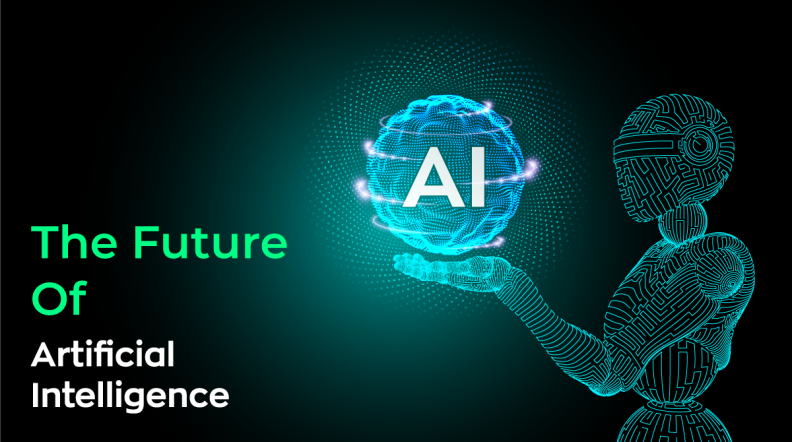The Future of AI: Navigating Through the Transformative Journey Ahead






The future of AI promises a transformative journey that will redefine every aspect of our society. As we stand on the brink of this new era, the anticipation around how artificial intelligence will evolve and shape our world grows. The potential applications of AI are boundless, extending from enhancing daily conveniences to solving some of the most complex global challenges.
Central to this evolution is the significant advancement in computer science and the development of sophisticated computer programs. These strides in technology have laid the groundwork for AI to transition from mere science fiction to a tangible reality that influences our everyday lives. As AI continues to mature, it is expected to become even more integrated into our daily routines, automating tasks with increased efficiency and opening new avenues for innovation.
However, with great power comes great responsibility. The rapid advancement of AI also poses ethical, privacy, and security concerns that need to be addressed. Ensuring the responsible use of AI will be critical in harnessing its full potential while safeguarding against its risks. As we navigate through this transformative journey, it is imperative to remain vigilant and proactive in shaping a future where AI benefits all of humanity.
The Evolution of AI Across Decades
The journey of AI has been marked by remarkable milestones, evolving through decades of research and development. From its initial conception in the mid-20th century to the sophisticated systems of today, AI has undergone exponential growth. This evolution has been fueled by breakthroughs in computer science, leading to the creation of advanced computer programs capable of tasks that were once deemed impossible for machines.
From Past to Present: Tracing AI’s Historical Milestones
The field of AI research has its roots deeply embedded in the history of computer science, tracing back to the mid-20th century when the phrase “artificial intelligence” was first coined. Since then, the field has witnessed exponential growth, paralleled by the surge in computational power. This growth trajectory has transformed AI from a nascent concept into a powerhouse of innovation, driving advancements across various sectors.
The Explosive Growth of AI: What Sparked the Revolution?
The explosive growth of AI in recent years can be attributed to several key factors. Advances in computational power and the availability of large datasets have propelled AI research and development. Additionally, the increased efficiency of algorithms has enabled the creation of more sophisticated AI applications. These technological advancements have collectively sparked the AI revolution, setting the stage for its unprecedented expansion across industries.
Frequently Asked Questions: Unraveling AI’s Evolution
Questions surrounding AI’s evolution are abundant, reflecting the public’s keen interest and sometimes concerns. A common inquiry is how AI is expected to integrate into our everyday lives. With advancements in AI technology, its applications are becoming increasingly prevalent, promising to enhance our lives with increased efficiency and convenience. Another frequent question focuses on AI’s impact on jobs, highlighting the need for adaptation in the workforce.
Unveiling the Impact: How AI Will Shape Our Future
The impact of AI on our future is profound, extending beyond the realms of science fiction. From decision-making processes in businesses to the federal government’s strategic planning, AI is set to revolutionize how we operate. The concept of human-AI teaming highlights the potential for a synergistic relationship between human intelligence and artificial intelligence, enhancing capabilities in various fields including education, where AI can tailor educational content to individual needs.
Job Disruption and the New Employment Landscape
The integration of AI into the workforce is poised to disrupt current job markets, creating a new landscape of employment opportunities and challenges. As automation and AI technologies become more prevalent, certain roles may become obsolete, while new ones emerge, necessitating a shift in skill sets and adaptability from the workforce. This evolution presents a dual-edged sword, offering efficiency and innovation on one hand, and posing risks of job displacement on the other.
Climate Change: AI’s Role in Fighting the Global Crisis
AI models are becoming pivotal in the fight against climate change, offering innovative solutions to one of the most pressing global crises. By analyzing vast datasets, AI can predict climate patterns, optimize energy consumption, and enhance the efficiency of renewable energy sources. This application of AI not only underscores its versatility but also highlights its potential to contribute positively to environmental sustainability.
Data Privacy and Security: Navigating the Digital Minefield
In the digital age, data privacy and security have become paramount concerns, with AI at the center of these discussions. Training data and generative AI tools have raised questions about the handling and protection of personal data. AI companies are now faced with the challenge of developing AI applications that respect data protection and data security principles, ensuring that the benefits of AI do not come at the cost of compromising individual privacy.
Regulatory Landscapes: Preparing for Increased Oversight
As AI technologies continue to evolve, so too does the landscape of regulatory oversight. Intellectual property rights, ethical considerations, and privacy concerns are prompting governments worldwide to establish frameworks for the responsible development and deployment of AI. This increased oversight aims to strike a balance between fostering innovation and protecting public interests, ensuring that AI serves as a force for good.
Industries Revolutionized by AI: Today and Tomorrow
AI programs are revolutionizing industries by introducing unprecedented levels of efficiency and innovation. From healthcare to finance, and transportation to education, the applications of AI are reshaping the way industries operate. This revolution is not just confined to the present but is set to continue shaping the future, promising a landscape where AI-driven solutions address complex challenges and create new opportunities.
AI in Healthcare: Redefining Patient Care and Medical Research
In healthcare, AI is redefining patient care and medical research through applications of AI in drug discovery and monitoring patients. Health systems are leveraging AI to analyze patient data, predict health outcomes, and personalize treatment plans, thereby enhancing the quality of care. The integration of AI in medical research is accelerating the development of new therapies, showcasing the power of AI to transform healthcare.
Transforming Transportation: AI’s Role in Future Mobility Solutions
The transportation sector is witnessing a significant transformation with the introduction of self-driving cars and autonomous vehicles. AI and machine learning technologies are at the forefront of this revolution, enabling vehicles to navigate complex environments safely. This evolution promises to enhance efficiency, reduce accidents, and redefine our concepts of mobility and transportation in the future.
AI in Manufacturing: Pioneering Efficiency and Innovation
The manufacturing industry has embraced AI with open arms, integrating robotic arms, predictive analysis sensors, and advanced AI to work alongside humans in tasks such as assembly and stacking. This transition, which began in earnest during the 1960s and 1970s, has been empowered by the power of AI to drive efficiency and innovation. By leveraging AI, manufacturers are not only optimizing production processes but also paving the way for a future of intelligent manufacturing.
The Rise of AI in Customer Service: Personalized and Efficient
AI is transforming customer service through the deployment of virtual assistants, offering personalized and efficient support to consumers. These AI-powered assistants are capable of handling a wide range of queries, providing instant responses, and learning from interactions to improve over time. This application of AI not only enhances the customer experience but also demonstrates the potential of AI to revolutionize service delivery models.
How AI is Changing the Face of Education: A New Era of Learning
The integration of artificial intelligence into education is ushering in a transformative era of personalized learning experiences. Through natural language processing, AI can adapt educational content to match the learning pace and style of each student, providing real-time feedback and assessments. Furthermore, facial recognition technology is being used to monitor student engagement and attendance, ensuring a more secure and focused educational environment. This new era of learning is characterized by its ability to cater to the unique needs of every student, making education more accessible and effective than ever before.
AI in Finance: Revolutionizing Banking and Investment Strategies
Financial institutions are leveraging advancements in artificial intelligence to redefine the landscape of banking and investment. AI algorithms analyze massive datasets to predict market trends, manage risks, and personalize customer experiences, making financial services more efficient and customer-focused. This revolution extends beyond automating mundane tasks to providing strategic insights that were previously unimaginable, enabling smarter investment strategies and financial planning. As AI continues to evolve, its potential to transform the finance industry becomes increasingly profound, promising a future where financial decisions are more informed, secure, and tailored to individual needs.
Media and Entertainment: AI’s Creative Disruption
The media and entertainment industry is experiencing a creative revolution powered by AI. From personalized content recommendations to AI-generated music and artworks, the technology is enabling new forms of creativity and entertainment experiences. AI algorithms analyze user preferences to curate content, enhancing viewer engagement and satisfaction. Additionally, AI-driven analytics provide insights into audience behavior, allowing creators to craft content that resonates more deeply with their audience. This creative disruption is not only changing how content is produced and consumed but also opening up new possibilities for storytelling and artistic expression.
Addressing the Risks: The Dark Side of AI’s Evolution
As AI technology advances, it brings with it potential risks that cannot be ignored. These include concerns over privacy, security, and the ethical implications of autonomous systems making decisions that affect human lives. The rapid pace of AI development necessitates a proactive approach to identify, understand, and mitigate these risks to ensure the technology benefits society as a whole. Addressing these challenges is crucial in fostering trust and ensuring the responsible deployment of AI technologies.
The Threat of Job Losses: Reality Versus Hype
The fear of job losses due to AI automation is a topic of intense debate. While certain roles may become exposed to AI, the technology also creates new opportunities for jobs that require AI skills. The key challenge lies in addressing the skills gap, ensuring workers are equipped with the knowledge and tools needed to thrive in an AI-driven economy. By focusing on education and training, we can prepare the workforce for the changes ahead, transforming the threat of job losses into an opportunity for career growth and innovation.
Confronting Human Bias in AI Algorithms
One critical issue in the deployment of AI technologies is the presence of human bias in AI algorithms. Virtual assistants, for example, rely on data that may inadvertently reflect societal biases, leading to discrimination and inequality. Addressing this challenge requires a concerted effort to develop AI systems that are transparent, equitable, and inclusive. By prioritizing fairness in AI development, we can harness the technology’s potential for good while minimizing its unintended consequences.
Deepfakes, Misinformation, and the Battle for Truth
The rise of deepfakes and the spread of misinformation present significant challenges in the digital age. AI technologies capable of creating realistic but fake audio and visual content are being used to manipulate public opinion and undermine trust in media. Combating this threat requires robust detection methods and a collaborative effort among technology companies, policymakers, and the public to promote digital literacy and safeguard the integrity of information.
The Specter of Automated Weaponry: Ethical and Moral Dilemmas
The development of automated weaponry raises profound ethical and moral dilemmas. The prospect of machines making life-and-death decisions without human intervention sparks debate over the moral implications and the risks of accidental escalation. Ensuring the responsible use of AI in defense requires international cooperation and stringent regulations to prevent the potential for unintended consequences and to uphold the principles of human dignity and international law.
The Fear of Superior AI Intelligence: Assessing the Existential Threat
The possibility of creating AI with intelligence surpassing human capabilities elicits fears of an existential threat to humanity. The lack of transparency in how advanced AI systems make decisions exacerbates these concerns. To mitigate these fears, it is essential to establish frameworks for the development of trustworthy AI, ensuring that such technologies are aligned with human values and controlled to prevent adverse outcomes.
The Road Ahead: Predictions and Preparations for the Next Decade
The next decade promises unprecedented advancements in AI and machine learning, heralding a new era of innovation and societal transformation. The development of trustworthy AI systems that are ethical, transparent, and aligned with human interests is paramount. As we stand on the brink of this technological frontier, preparing for the future involves not only embracing the potential of AI but also addressing the challenges it presents, ensuring a future where technology enhances human welfare and prosperity.
What Will the Future of AI Look Like in the Next 10 Years?
In the next decade, we can expect AI technologies, including advanced neural networks and fraud detection systems, to become more sophisticated and integrated into every aspect of our lives. From enhancing healthcare with predictive analytics to revolutionizing industries with smarter automation, AI’s potential is boundless. However, ensuring the ethical use and equitable access to these technologies will be crucial in shaping a future that benefits all of humanity.
Preparing for the Future: Key Strategies and Recommendations
As we navigate the future of AI, adopting key strategies and recommendations will be crucial for success. This includes investing in education and training to equip the workforce with necessary AI skills, fostering innovation while ensuring ethical standards, and promoting collaboration between governments, private sector, and academia. By taking proactive steps today, we can pave the way for a future where AI serves as a force for good, driving economic growth and improving quality of life.
Embracing Change: How Businesses and Individuals Can Adapt
Adapting to the AI revolution requires businesses and individuals to embrace change and leverage the opportunities it presents. By harnessing massive amounts of data for informed decision-making and innovation, organizations can stay ahead in a competitive landscape. For individuals, lifelong learning and adaptability are key to thriving in an AI-driven world. Embracing AI’s potential while being mindful of its challenges will be critical in navigating the future successfully.
Breaking Down Myths: Separating Fact from Fiction in AI
In the discourse surrounding AI, it is imperative to separate fact from fiction to understand the technology’s true potential and limitations. Dispelling myths and misconceptions fosters a more informed public dialogue, paving the way for the responsible development and deployment of AI. By critically examining the narratives around AI, we can demystify the technology and embrace its benefits while being cautious of its risks.
Debunking Common AI Myths: Setting the Record Straight
Common myths about AI often exaggerate its capabilities or dangers, leading to misconceptions about the technology. By setting the record straight, we clarify that while AI has the potential to transform industries and improve lives, it remains a tool created and controlled by humans. Understanding AI’s actual capabilities and limitations is essential in leveraging its benefits and addressing the ethical and societal challenges it presents.
The Reality of AI’s Capabilities and Limitations
The journey of AI research has been marked by significant milestones, with the phrase “artificial intelligence” increasingly becoming a household term. Despite its exponential growth, AI’s capabilities are inherently tied to the available computational power and the sophistication of emerging technologies. While AI can process and analyze data at speeds incomprehensible to humans, it lacks the intuitive decision-making and emotional intelligence inherent to the human mind. Understanding AI’s limitations is crucial for leveraging its strengths effectively.
Advanced AI Technologies on the Horizon
The misconception that AI will replace human roles across all sectors fails to account for the nuanced reality. Advanced AI technologies are being developed to augment human capabilities, not just replace them. These technologies aim to take over repetitive tasks, allowing humans to focus on creative and strategic roles that AI cannot fulfill. The future lies in symbiotic relationships between humans and AI, where each plays to their strengths.
Generative AI and Language Models: Crafting the Future of Communication
Today’s AI revolution is significantly shaped by the advent of generative AI and language models, transforming content creation and communication. In the healthcare industry, electronic health records are being streamlined by AI, enhancing patient care. Similarly, language models are revolutionizing banks and financial institutions by improving data science applications. However, as AI development accelerates, it raises concerns about the integrity and authenticity of generated content, underscoring the need for vigilant oversight.
AI and Privacy: Enhancing Security in the Digital Age
The proliferation of AI technologies has underscored the critical issue of data privacy, with a particular focus on the lack of transparency in how personal information is used. Safeguarding privacy in the age of AI requires robust frameworks that not only protect data but also ensure transparency in AI operations. This balance is essential for maintaining trust in digital ecosystems and for the responsible growth of AI applications.
AI’s Global Influence: A Look at its Role in Various Regions
AI poses unique opportunities and challenges across different regions, reflecting the diverse landscape of global technological adoption. In some areas, AI is a catalyst for innovation, driving economic growth and enhancing quality of life. In others, it presents challenges related to workforce displacement and ethical considerations. The global influence of AI is a testament to its transformative potential, necessitating a nuanced understanding of its impact across various cultural and economic contexts.
How Different Countries are Shaping and Being Shaped by AI
AI technology is at the forefront of a global transformation, with potential applications spanning across numerous sectors. Countries harnessing AI are witnessing significant advancements in automating routine tasks and optimizing repetitive tasks, showcasing the benefits of AI in enhancing efficiency and productivity. This global embrace of AI highlights the importance of international collaboration in developing standards and practices that maximize the positive impacts of AI while mitigating its risks.
Crafting the Path Forward: A Conclusion
The development and integration of language models into various sectors underscore the profound impact AI will continue to have on society. As these models evolve, they offer unprecedented opportunities for enhancing communication, automating complex tasks, and generating new insights. The path forward requires a balanced approach that fosters innovation while addressing ethical and practical challenges posed by AI technologies.
The Unstoppable March of AI: Embracing the Inevitable Evolution
The fields of computer science and artificial intelligence technology are advancing at a rapid pace, fueled by extensive scientific research and national AI initiatives. From pilot programs testing the limits of AI’s capabilities to comprehensive strategies aiming to integrate AI into every aspect of life, the march of AI is indeed unstoppable. Embracing this evolution involves preparing for its implications, both positive and negative, and ensuring that AI development is guided by ethical considerations and human values.